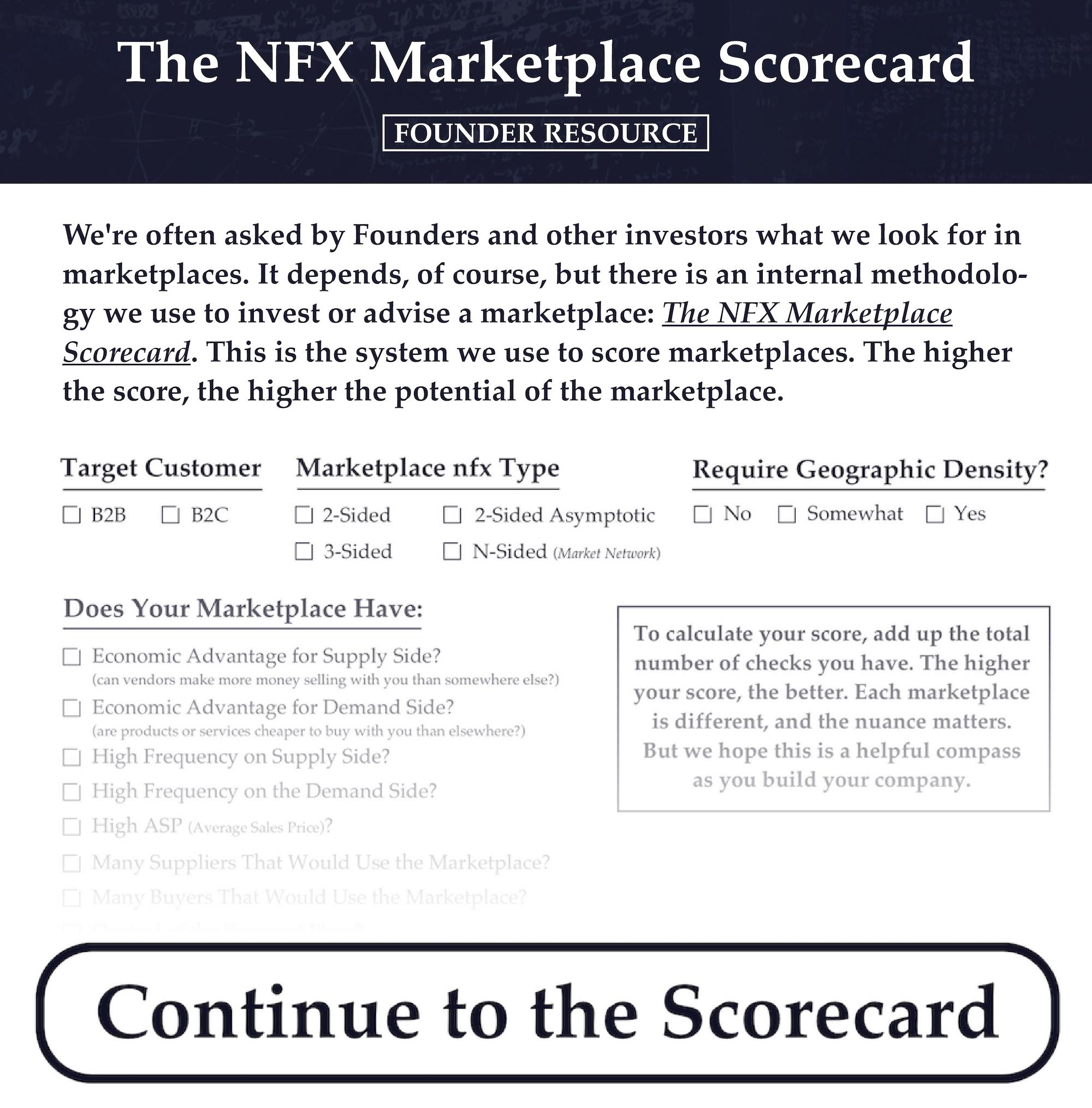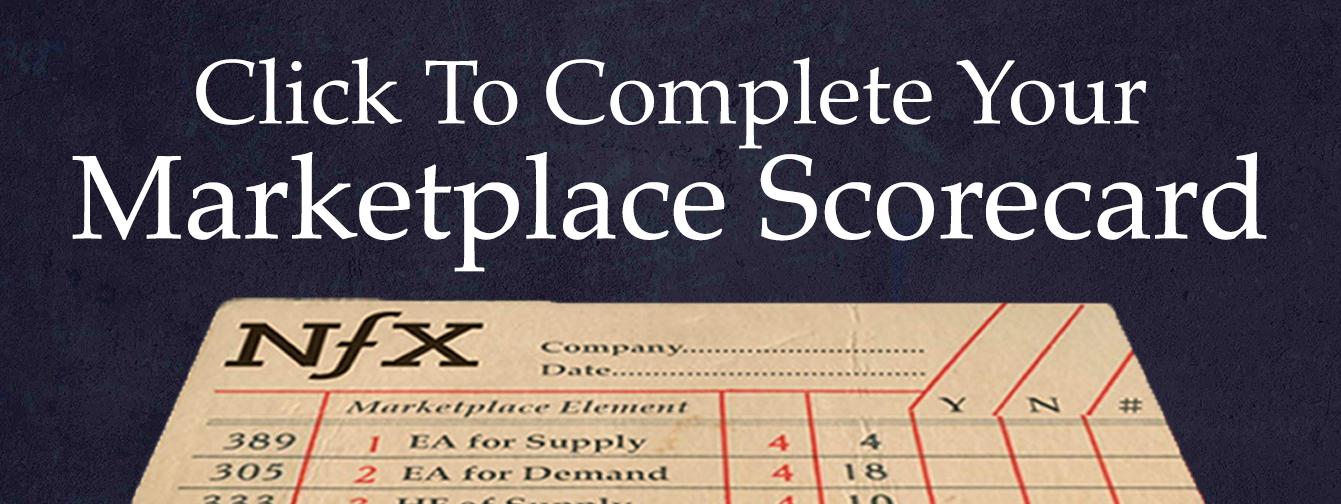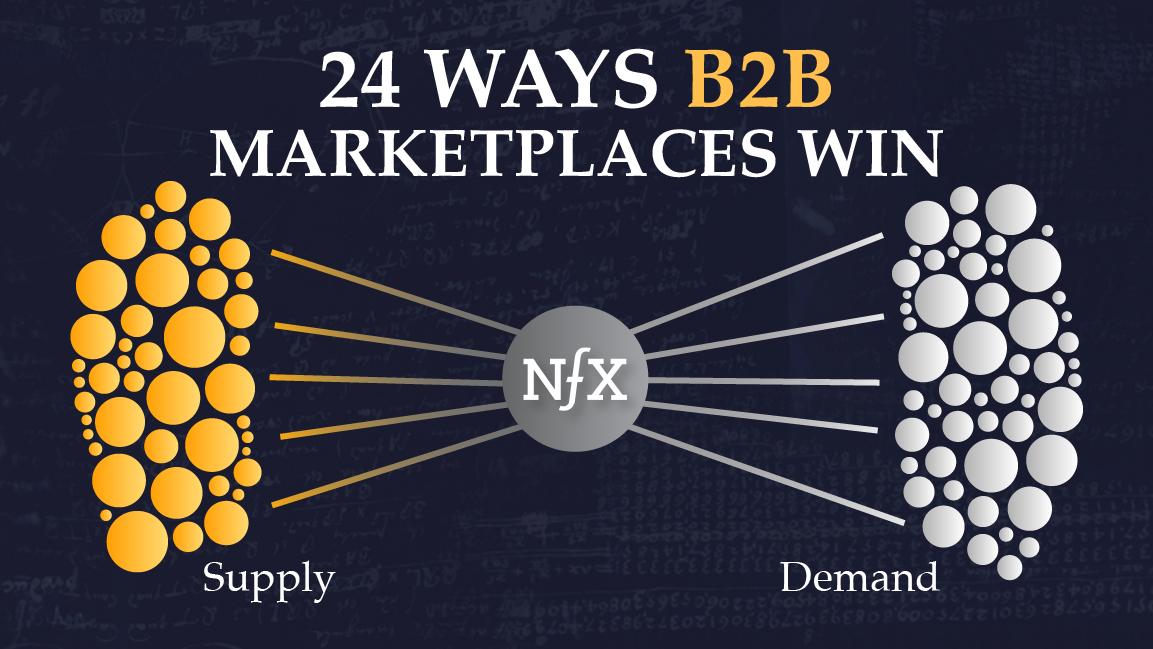

The internet is 30 years old, but business to business commerce and services remain stuck in the past. Most companies still don’t use modern software.
20 years ago, with much fanfare, Founders and VCs made an attempt to bring many B2B marketplaces online. It failed spectacularly (see the final section of this essay for more discussion of this).
Finally, 20 years later, a lot has changed, and B2B marketplaces are starting to work.
I see 6 general reasons why:
- Online purchasing became normalized for consumers. People expect the same interface when buying at work for B2B.
- Financial infrastructure that didn’t exist before is now available.
- The scale of the internet is far bigger, meaning more opportunity for liquidity. There were only about 300 million people on the internet during the first wave of B2B marketplaces.
- Prevalence of mobile and IoT devices. It’s now easier to get the supply and data into the system, allowing for automated inventory/reselling/tracking, etc.
- There’s more willingness by Founders to operate managed marketplaces — taking on logistics and fulfillment, transactions, QA services, and building trust online.
- The ownership of many businesses has been passed onto a more digitally literate generation.
Just as the last 15 years have seen tremendous consumer marketplace success stories, we expect to see the same level of success for B2B marketplaces over the next 10 years.
Today, we’re sharing 24 ways to make B2B marketplaces work. Founders who can execute using these lessons will be in a position to revolutionize B2B markets.
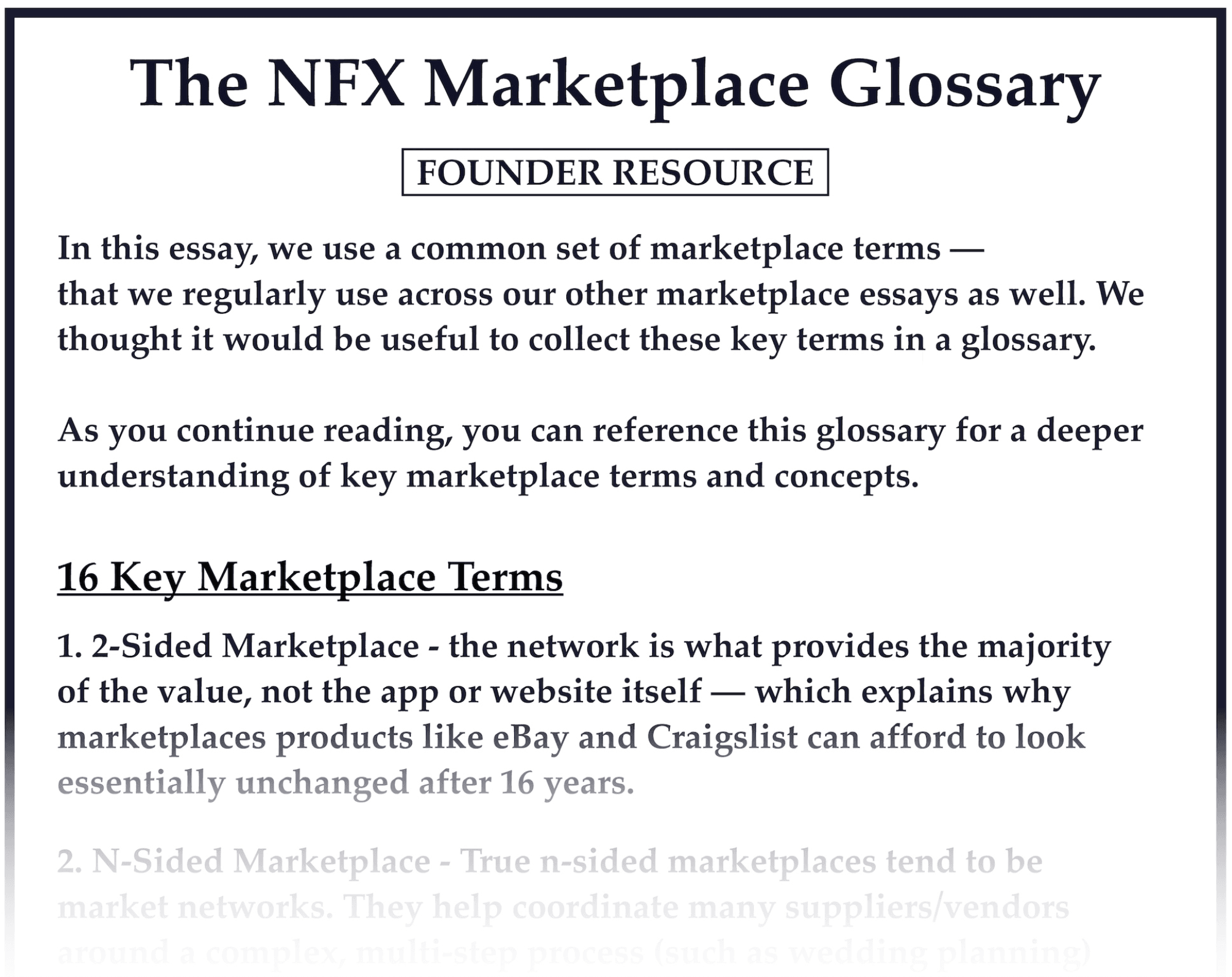

1. Create a new set of transactions
Find transactions that are not happening today, and enable them to happen. Most Founders see a market and say “How can I digitize that transaction and capture a percentage of it?” That’s fine. But sometimes it’s better to say “Who isn’t making any money in this market at all? Who can I help launch into business in this market?”
If you can take “non-participants” from $0 revenue to $X revenue, and if they can build their business around your marketplace, they will become loyal nodes in your marketplace, helping you grow with less resistance.
This is important because other companies that have revenue under the status quo will resist your growth. They will worry that as your marketplace changes their market, they could lose revenue, lose margin, or lose an advantage they think they have today. This risk aversion is simple human nature.
2. Understand B2B buyer psychology
In B2B, buyers’ minds are focused on their margins. That’s the core of their business. And they’re highly aware that your rake could cut into their margins.
They also care about quality, certainty, and the hope that the purchase will give them an advantage against their competition now and in the future. A B2B buyer brings a rational, multi-level consideration set to transacting on your marketplace.
Further, a company buying from you could become dependent on you for their margins, and thus their livelihood. You could make or break them, which is a lot of risk for them. So you can see why so many established businesses are wary of B2B marketplaces.
Contrast this to buyers on B2C marketplaces who typically use a marketplace for convenience, speed, and availability. They are much less sensitive to your rake, and they’re more interested in finding what they’re looking for and getting it quickly. And since a B2C marketplace only controls a fraction of their lives, they don’t worry about whether they buy it from your B2C marketplace or some other source.
3. Become a student of clever pricing strategies
Because B2B buyers and sellers are much more sensitive to margins, pricing — and how it’s communicated — is key to making a B2B marketplace work. You must become a student of clever pricing strategies. Do you put the rake on the buyer, the seller, or both? Do you build your rake into the named price? Do you show pricing? A traditional rake might not be the best way to monetize. So be sure to experiment and iterate on it with knowledge of what has been tried before.
4. Look for the “network interrupt”
In B2B, you are often going up against an “if it’s not broken, don’t fix it” mentality. People have grooved into their current workflow/decision-making and prefer to stick with what they know. This compounds across an industry. Think of a market like a network of people. If everyone in the industry is doing things a similar way, it will feel like more of a risk to try something new, even for the sake of greater efficiency.
B2B marketplaces should look to create a “network interrupt” that forces people out of their patterns. A network interrupt can come in the form of a new economic reality or emerging technology that changes the experience dramatically. Or it can arise from a competitive situation — for example, if your marketplace empowers one visible node in a new way that causes the other nodes to react out of perceived competitive pressure.
5. Start on the outskirts
Don’t immediately try to attack the center stronghold controlled by winners and market incumbents. They have a vested interest in preserving the status quo because they often have more to lose than to gain if the market is made more efficient.
Instead, it might be a better strategy to start on the outskirts of the market and work your way in. Focus on the marginal nodes with the most to gain from a new way of doing things. This can be the best strategy until you hit a critical mass in your marketplace and get your 2-Sided Marketplace nfx going.
6. Talk to customers, build friendships
For B2B marketplaces, ongoing customer insight is critical. Talk to your customers. Don’t just watch the data coming out of your software. Get to be friends with people. Reach out to them directly, on video calls, phone calls, emails, texts, and meet up with them for breakfasts, lunches, dinners, conferences, weddings, etc.
During several periods in the evolution of your B2B marketplace, you should expect to spend 50% of your time talking to your users directly, asking them questions, and getting feedback.
7. Avoid markets that are too consolidated
We wrote in the NFX Marketplace Scorecard that online marketplaces typically do best when there is a high degree of fragmentation on both sides of the market. If there are only a few sources of supply or demand in a B2B market category, online marketplaces will not see much success.
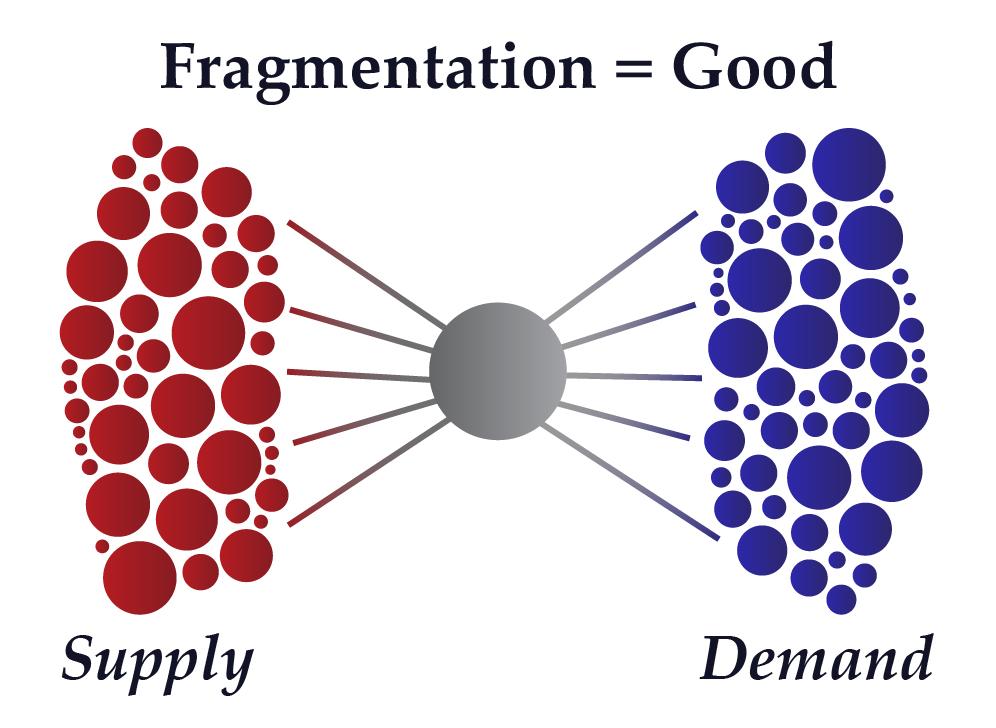

This is because fragmentation is an indicator of lots of competition, so 2-Sided Marketplace nfx will be quite powerful when fragmentation is high — once a critical mass on one side of the market joins a marketplace, their competitors will have no choice but to follow.
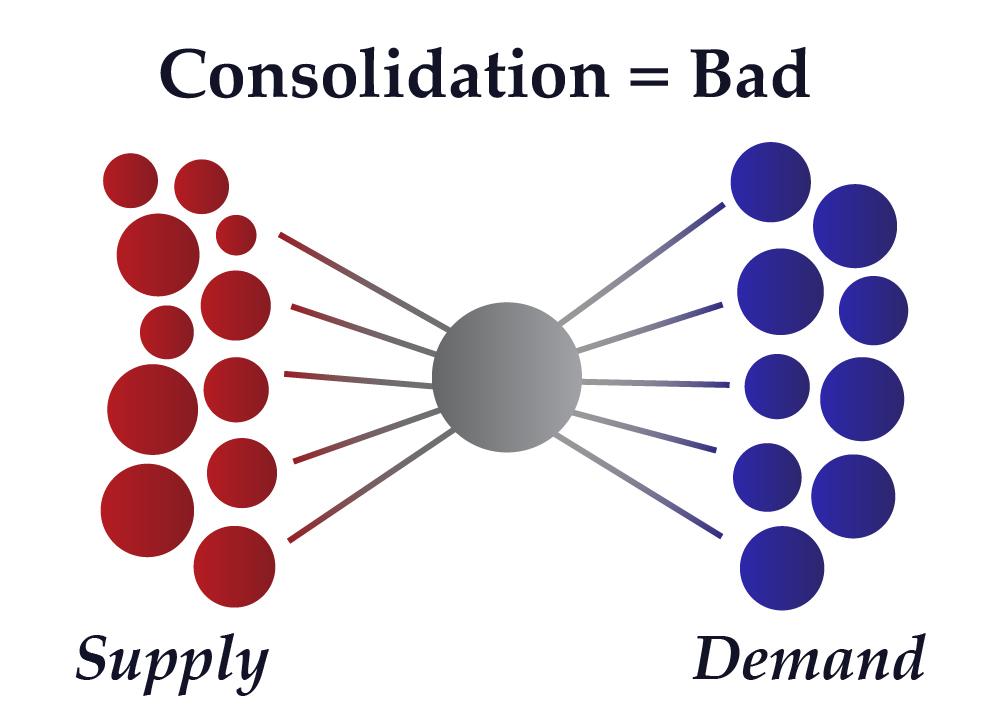

Consolidation in the market, however, means that the powerful players on either side will be able to leverage their market share to prevent the successes of new marketplace entrants. Either that or the marketplace will be overly reliant on big players and will be crippled if any one customer defects. Either way, it’s not ideal for building a marketplace.
8. Have patience, and be relentless through seasons
Remember that B2B marketplaces are “hard planes to fly” and they take 5-8 years to get going. So the pilots — the founding team — need to be data-driven, humble, and tireless to keep flying that plane properly.
Your B2B marketplace will go through many seasons, and the product needs to do different things in each of the different seasons. Be prepared to adapt with pricing, guarantees, supply-side concentration, geographic restrictions, press announcements or stealth, special incentives to certain nodes to get their commitment, SaaS tools to lock in one side or the other, allowing disintermediation and then stopping it, fintech augmentation, etc.
9. Become a broker yourself
In many B2B markets, brokers serve as intermediaries between buyers and sellers. They provide trust and consultation services for both sides in a situation where the transactions are large and buyers often need help selecting the right supply for their needs.
Simply matching supply and demand is often not enough. Discovery was the primary function of the first generation of “listings” marketplaces, but this model is not as useful for B2B. One strategy is to become a tech-enabled brokerage yourself, then move to automating on one or both sides of the marketplace later.
10. Build software for brokers
A second strategy to deal with B2B markets where brokers are prevalent is to give them the software, data, and access to supply or demand to enable them to do their jobs better. This converts brokers from obstacles of your marketplace into advocates.
My partner Pete Flint, for example, did this when building Trulia by creating an XML feed standard allowing real estate brokers to syndicate their listings to Trulia from their own websites, saving them time and effort while expanding their exposure.
11. Offer a free/subsidized trial
Keeping a business from having to go through the internal politics of having to decide to spend money — or give up a percentage rake — can speed up your sales cycle.
Of course, offering a free trial can be dangerous. You have to do it in the right way. A few ideas we’ve seen work:
First, be clear about what the real cost will be in the future once the trial expires — not just with your point of contact at the company, but everyone else behind them who will be displeased if they aren’t aware of what happens when the trial expires.
Second, create a “Pioneers Club”: a limited-access group of early customers. This makes it known that there are only a limited number of trials being offered so that people feel they have to hurry before someone claims their spot. Further, limited access also lets you explain to later users why they aren’t getting the same deal since the Pioneers Club is closed. You’ll be able to explain that it was a limited trial period.
Offering a free/subsidized trial can also help you deal with the chicken-or-egg problem, a problem we’ve previously written about when we first revealed the 19 tactics for solving this classic marketplace problem.
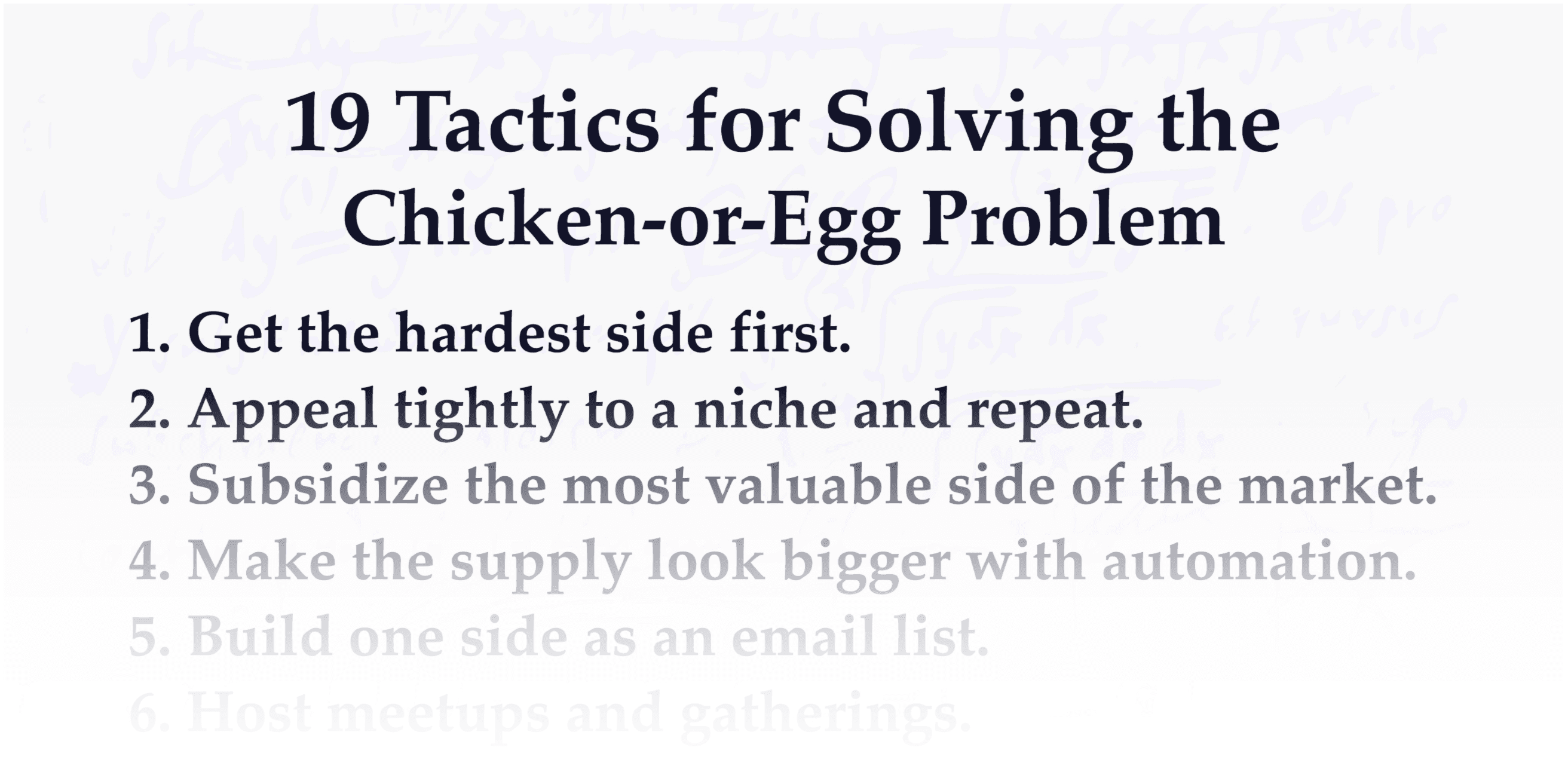

12. Communicate your growth path with attention to the details
Remember, B2B market nodes tend to be tight-knit. Everyone talks. The network density is very high. They all know each other from the trade conferences, the councils, and the industry dinners. You have to assume that everything you tell one person in the market will be known by everyone else. How you build your marketplace will become known, so how you start and grow needs to be carefully scripted and communicated.
13. Establish trust with KYC services
B2B marketplaces should consider doing background checks on nodes on both sides of the marketplace so that you can establish trust in your brand. Trust is key. In the last 6 years, KYC (know your customer) companies have become more available and make it easier to do this.
14. Add consultation services
A big part of the way offline B2B markets work today is to include nuanced and personalized information with transactions.
For example, when I buy water pipes from a broker, they give me advice on the different product options, regulations that might apply, and tips on how to use them best — information that would be hard to find in a different way, and is tailored to my unique situation.
As a marketplace, in order to compete with the brokers entrenched in a vertical, you might have to offer similar value. Inventory is often only part of the equation.
15. Add coordinators
To create liquidity in your marketplace, you might need to become a managed marketplace where you add a product manager or coordinator to manage different pieces of the supply side to create an adequate (liquidity-creating) product for the demand side. This can appear to be “free” work that the marketplace does. In reality, this is an extra cost to you, and you need to be sure to get adequate rake in the marketplace to cover these additional costs.
16. Create SaaS workflow tools
Create workflow tools for embedding for one or both sides of the marketplaces to incentivize repeat usage on both sides without multi-tenanting.
This can’t be emphasized enough.
We’ve written about the 4 types of defensibility here. The network effect defensibility you’re trying to achieve with your marketplace is the big prize, but the “embedding” defensibility is the intermediate prize where you embed your SaaS tool into the workflow of your demand-side or supply-side nodes. So yes, this requires you to become a SaaS company. But this doesn’t mean you have to charge them a subscription fee like a SaaS company would because your revenue model can be around marketplace transactions.
Another way to think about it is that you’re building a free or nearly-free SaaS tool company that monetizes on the transactions.
17. Find the “white-hot center”
Instead of trying to capture an entire market category all at once, it’s smarter to appeal to a focused niche. Target the right segment of buyers or sellers to start with. Find the people in your market category who are most in need of the supply or demand you can unlock for them. Capture 85%+ of these best nodes’ volume and expand from there.
18. Focus on the harder side of the marketplace
Early on in building a marketplace, you have to figure out whether supply or demand is more difficult to attract and focus your whole company on that. In some B2B marketplaces, if you get supply, the demand will show up. In others, if you find demand, the supply will show up.
One of the big mistakes a Founder can make is to prematurely split the company into two teams, one in charge of growing the supply side and one on the demand, when growing only one side really matters. For human reasons, the rest of the people in your company will naturally try to support both people. Both sides will want to take up air time at company meetings and be acknowledged for their work. And it’s a distraction.
What you really want is to determine which side is harder and then put the whole company on that one side. At the early stages, the other side really doesn’t matter.
19. Become a Fintech-Enabled Marketplace
As online marketplaces have evolved over the last 10 years, there has been a consistent progression towards capturing more and more of the transaction online.
Adding fintech support for marketplace participants including insurance, financing, etc. will help guard against disintermediation and multi-tenanting. B2B transactions enabled by financial services will create higher retention and a more seamless experience.
20. Go mobile
A B2B company can still get a big advantage doing something excellent on mobile. 100% of the employees of a business are on mobile because of their personal smartphones — but most B2B marketplaces have done little with mobile.
There are many opportunities, but you can imagine that maps, real-time tracking, mobile price bidding, availability alerts, quickpay, messaging, video voicemails, and other mobile-first features would be valuable for B2B.
Ask yourself: what would make a standout or can’t-live-without feature for the supply or demand side that would be enabled by mobile?
21. Use notifications to maximize transparency
Delivery tracking and notifications are already prevalent in food delivery and ecommerce. Uber Eats and Amazon send you notifications when you can expect your order to arrive, and this consumer expectation will cross over into B2B.
People will want to know the status of their transaction. Delivery notifications at every step of the way, using maps of the location of the order, or at least a map of where in the process a transaction is, makes the timing of the transaction transparent to both sides. This will give them the feeling of having more control and visibility into when and where they are getting the thing they are buying.
22. Provide an intermediate warehousing step
It’s expensive and a pain, but full service via providing warehousing yourself might be what you need to grow the network and add enough value not to be disintermediated.
This is an offline way to own more of the transaction. Some would call this a “managed marketplace,” where you’re guaranteeing a certain service level. You take on more revenue but also more cost and risk.
23. Hire the best salespeople in your market
In building a marketplace, getting to liquidity is everything. By bringing top-performing salespeople and former brokers from your market onto your team with the promise of working with a modern, faster competitor, you can bootstrap your distribution. Have them bring their book of business and expertise with them.
24. Target new products and new services
New products or services that didn’t exist before are often a good way to break into a market because the margins are higher and the market is not yet efficient. New enabling technologies open up new greenfield opportunities that incumbents overlook because they’re busy focusing on their core business. By creating new supply or demand you can create blue ocean opportunities.
Why Now Is The Time To Build B2B Marketplaces
20 years ago, optimism for B2B marketplaces was high, and there was a large influx of capital to startups. They failed, creating a cloud of disappointment and skepticism that has haunted B2B marketplaces ever since.
They included procurement marketplaces like FreeMarkets and Vertical Net, Chemdex and Chemconnect in chemicals, E-steel and Quadrem in metals. The list goes on. Hardly any of them are still around.
As we listed above, there were a few reasons why the first wave failed. We believe these reasons no longer apply, and that B2B marketplaces built in the 2020s will fare far better.
We’ve written before that startup timing is about three critical factors: economic impetus, user behavior, and enabling technologies. All three are much more favorable for online B2B marketplaces after 20 years.
Founders have to overcome serious obstacles to successfully build B2B marketplaces.
For Founders who can successfully navigate, the opportunity is there to build transformative and iconic companies in this space over the next ten years, bringing the biggest markets in the world — B2B markets — online and into a new era.
As Founders ourselves, we respect your time. That’s why we built BriefLink, a new software tool that minimizes the upfront time of getting the VC meeting. Simply tell us about your company in 9 easy questions, and you’ll hear from us if it’s a fit.
